As children navigate their lives and the world around them, they often encounter a range of challenges that can lead to feelings of anxiety and stress. From school pressures to social interactions and family dynamics, these experiences can sometimes feel overwhelming. As parents, caregivers, or educators, finding effective ways to support children through these anxious moments is crucial. One powerful tool that can help is meditation.
Understanding Anxiety in Children
Anxiety in children can manifest in various ways, including:
- Excessive Worry: Persistent and intense fear about everyday situations.
- Physical Symptoms: Complaints of stomachaches, headaches, or other physical discomforts.
- Avoidance: Steering clear of activities or situations that provoke anxiety.
- Sleep Disturbances: Difficulty falling asleep, staying asleep or frequent nightmares.
- Behavioural Changes: Increased irritability, restlessness, listlessness or changes in mood.
Addressing anxiety early and effectively is essential for helping children build resilience and coping skills. Meditation offers a gentle yet effective approach to managing anxiety: fostering a sense of calm and emotional stability.
How can meditation benefit my anxious child?
- Promotes Relaxation: Meditation helps activate the body’s relaxation response, reducing physical symptoms of anxiety such as increased heart rate and muscle tension.
- Enhances Self-Awareness: Through meditation, children learn to observe their thoughts and feelings without judgment, helping them understand and manage their anxiety more effectively.
- Improves Focus and Attention: Regular meditation practice can enhance concentration and cognitive function, making it easier for children to stay engaged and calm in challenging situations.
- Fosters Emotional Regulation: Meditation teaches children techniques for regulating their responses to stress and anxiety. Meditation also supports children to learn to self-soothe and regulate their emotions more effectively.
- Encourages Mindfulness: Mindfulness meditation helps children stay present in the moment, reducing the tendency to ruminate on past worries or future uncertainties.
- Builds Resilience: By developing a meditation practice, children learn valuable coping skills that can help them navigate future challenges with greater ease.
Simple Meditation Techniques for Children
- Mindful Breathing:
- How to Practice: Have your child sit comfortably with their eyes closed. Encourage them to take slow, deep breaths in through their nose and out through their mouth. Guide them to focus on the sensation of their breath entering and leaving their body.
- Duration: 1-5 minutes.
- Guided Imagery:
- How to Practice: Lead your child through a calming visualization exercise. For example, ask them to imagine a peaceful place like a beach or a forest. Describe the sights, sounds, and sensations they might experience in this place.
- Duration: 3-10 minutes.
- Body Scan:
- How to Practice: Have your child lie down or sit comfortably. Guide them through a body scan by asking them to focus on each part of their body, starting from their toes and moving up to their head. Encourage them to notice any sensations or tensions and let them go with each exhale. This can be incredibly effective at bed time and is called ‘beditation’ by some children I work with.
- Duration: 5-10 minutes.
- Gratitude Practice:
- How to Practice: Ask your child to think of or say three things they are grateful for. This practice shifts focus from worries to positive aspects of their life, promoting a sense of well-being.
- Duration: 1-3 minutes.
- Mindful Listening:
- How to Practice: Play a short piece of calming music or nature sounds. Encourage your child to listen carefully and notice the different sounds they hear. Afterward, discuss their observations and feelings.
- Duration: 2-5 minutes.
Tips for Integrating Meditation into your child’s Routine
- Start Small: Begin with short, manageable sessions to help your child get accustomed to meditation. Gradually increase the duration as they become more comfortable.
- Make It Fun: Incorporate elements that appeal to your child, such as guided meditations with characters or themes they enjoy. Use colourful and engaging resources designed for children.
- Be Consistent: Establish a regular meditation routine, such as practicing together before bed or after school. Consistency helps create a sense of stability and familiarity.
- Model the Behaviour: Practice meditation yourself to demonstrate its benefits and show that it’s a valuable tool for managing stress and anxiety.
- Create a Calm Space: Set up a designated meditation area that is quiet and free from distractions. Decorate the space with calming colours and soothing objects to make it inviting.
- Encourage Expression: Allow your child to express their feelings about meditation and adjust practices based on their feedback. Ensure they feel comfortable and supported throughout the process.
Conclusion
Meditation can be a powerful tool for supporting children with anxiety, offering them valuable skills to manage their emotions and find calm amidst life’s challenges. By incorporating simple meditation techniques into their daily routine, children can develop resilience, enhance self-awareness, and cultivate a more positive outlook. As parents, caregivers, or educators, your role in guiding and supporting their meditation practice can make a significant difference in their journey towards emotional well-being. Embrace the transformative potential of meditation and help children discover a sense of inner peace and confidence that will serve them throughout their lives.





